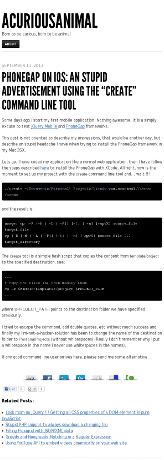Taking web page screenshots
15 September, 2012 - 4 min read
Recently I have worked on system that requires to take web page screenshots. Not only a screenshot of the whole page but of a concrete element.
Looking on the net I have found many solutions for this problems, which can be classified in to categories:
- Local applications: I mean a screen capture program or a plugin for your browser (both Chrome and FireFox has some nice plugins for this).
- Online services: There are some online services that offers possibility to get a screenshots (like url2png), test your web site on different browsers (like browsershots or browserling) or even an API to automatize the task to capture a web page (like thumbalizer or url2png).
The solution
There are alternatives but I like to go beyond the easy solutions and try things, so, after looking a bit more I found a powerful solution: PhantomJS.

Oh, wonderful, but.. what is PhantomJS and what is it good for?
As the project page says:
PhantomJS is a headless WebKit with JavaScript API. It has fast and native support for various web standards: DOM handling, CSS selector, JSON, Canvas, and SVG.
PhantomJS is created by Ariya Hidayat.
This means you have all the powerful of a WebKit based browser within a program, so you can use it for: headless website testing, site scraping, page rendering, network monitoring, ...
How to use PhantomJS to take a web page screenshot?
Go to the project page and download the binary package . In my case I download the Linux 64-bit system.
PhantomJS is a command line tool and, once and uncompressed the previous package, you will find it in the bin/phantomjs. As a command tool the usage looks like:
./phantomjs [options] script.[js|coffee] [script argument [script argument ...]]
You can get more usage information with: ./phantomjs --help
PhantomJS accepts programs coded in JavaScript or CoffeeScript and, hopefully, the package comes with a examples folder which is full of examples in both languages.
One of the sample programs is the rasterize.[js|coffee] which shows how we can rasterize a web page to an image file.
The program usage is:
./phantomjs rasterize.js URL filename [paperwidth*paperheight|paperformat] [zoom]
And the whole program code is:
var page = require('webpage').create(),
system = require('system'),
address, output, size;
if (system.args.length < 3 || system.args.length > 5) { console.log('Usage: rasterize.js URL filename [paperwidthpaperheight|paperformat] [zoom]'); console.log(' paper (pdf output) examples: "5in7.5in", "10cm20cm", "A4", "Letter"'); phantom.exit(1); } else { address = system.args[1]; output = system.args[2]; page.viewportSize = { width: 600, height: 600 }; if (system.args.length > 3 && system.args[2].substr(-4) === ".pdf") { size = system.args[3].split(''); page.paperSize = size.length === 2 ? { width: size[0], height: size[1], margin: '0px' } : { format: system.args[3], orientation: 'portrait', margin: '1cm' }; } if (system.args.length > 4) { page.zoomFactor = system.args[4]; } page.open(address, function (status) { if (status !== 'success') { console.log('Unable to load the address!'); } else { window.setTimeout(function () { page.render(output); phantom.exit(); }, 200); } }); }
Probably the most important sentences are:
- The inclusion of the webpage module:
var page = require('webpage').create(); - Load the web page with
openfunction:page.open(address, function (status) { ...}; - Render the web page to a file with the
renderfunction:page.render(output);
Note also in the rasterize.js source code the page.viewportSize is defined to be 600x600 which is equivalent as we where navigating a page with a screen resolution of 600x600.
Lets to to see a sample and take a screenshot of this blog site:
./bin/phantomjs ./examples/rasterize.js http://acuriousanimal.com/blog acanimal_blog.png
This makes a screenshot of the whole blog site. Here I attached a modified version of the image with lot less resolution of the original, but you can get an idea of the powerful of PhantomJS.:
